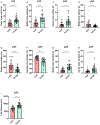Sex differences in the elevated plus-maze test and large open field test in adult Wistar rats
- PMID: 33684454
- PMCID: PMC8130853
- DOI: 10.1016/j.pbb.2021.173168
Sex differences in the elevated plus-maze test and large open field test in adult Wistar rats
Abstract
There is a growing need for a better understanding of sex differences in animal models of psychiatric disorders. The elevated plus-maze (EPM) test and large open field (LOF) test are widely used to study anxiety-like behavior in rodents. Our studies explored sex differences in anxiety and activity parameters in the LOF and EPM and determined whether these parameters correlate within and between tests. Drug naïve adult male and female Wistar rats (n = 47/sex) were used for the studies, and the rats were tested for 5 min in the EPM and 10 min in the LOF. The females spent more time on the open arms of the EPM and made more open arms entries than the males. The females also spent more time in the center zone of the LOF and made more center zone entries. The females traveled a greater distance in the LOF and EPM. There was a moderate positive correlation between time on the open arms of the EPM and time in the center zone of the LOF. There was also a moderate positive correlation between open arms entries in the EPM and center zone entries in the LOF. A hierarchical cluster analysis revealed one cluster with LOF parameters, one cluster with EPM parameters, and one cluster with parameters related to the avoidance of open spaces. In conclusion, these findings indicate that female rats display less anxiety-like behavior in the EPM and LOF. Furthermore, there are sex differences for almost all behavioral parameters in these anxiety tests.
Keywords: Anxiety; Dendrogram; Elevated plus-maze; Hierarchical cluster analysis; Open field; Sex.
Copyright © 2021 Elsevier Inc. All rights reserved.
Conflict of interest statement
Figures







References
-
- Asami T, Yamasue H, Hayano F, Nakamura M, Uehara K, Otsuka T, Roppongi T, Nihashi N, Inoue T, Hirayasu Y, 2009. Sexually dimorphic gray matter volume reduction in patients with panic disorder. Psychiatry Research: Neuroimaging 173(2), 128–134. - PubMed
-
- Blizard DA, Lippman HR, Chen JJ, 1975. Sex differences in open-field behavior in the rat: the inductive and activational role of gonadal hormones. Physiology & behavior 14(5), 601–608. - PubMed
Publication types
MeSH terms
Grants and funding
LinkOut - more resources
Full Text Sources
Other Literature Sources
Medical

